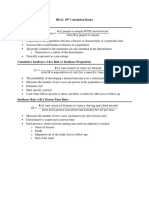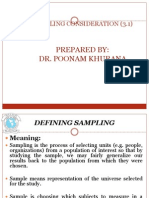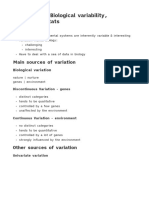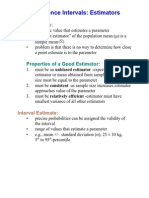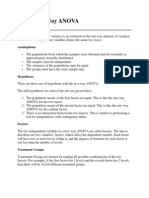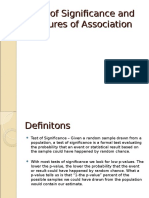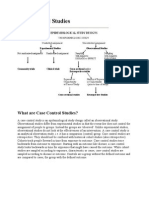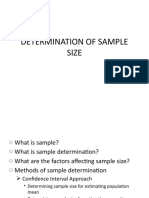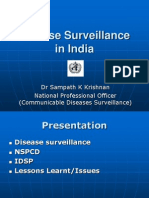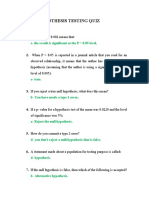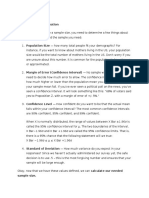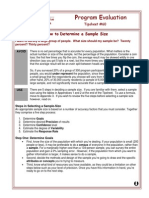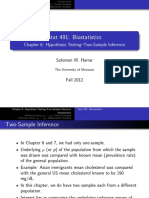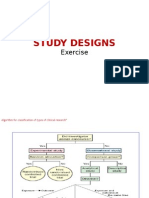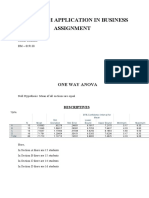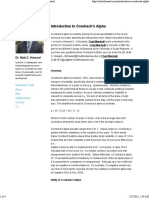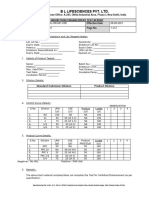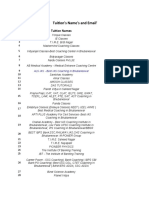0 ratings0% found this document useful (0 votes)
325 viewsP Value
P Value
Uploaded by
asdf0288The p-value is used in statistical hypothesis testing to represent the probability of obtaining a result at least as extreme as the observed result, assuming the null hypothesis is true. A lower p-value provides more evidence against the null hypothesis. The null hypothesis is generally rejected if the p-value is less than or equal to the pre-determined significance level, often 0.05. However, critics argue that the significance level is arbitrary and that the p-value does not represent the probability that the null hypothesis or an alternative hypothesis is true. There are also common misunderstandings about what the p-value represents.
Copyright:
© All Rights Reserved
Available Formats
Download as PDF, TXT or read online from Scribd
P Value
P Value
Uploaded by
asdf02880 ratings0% found this document useful (0 votes)
325 views2 pagesThe p-value is used in statistical hypothesis testing to represent the probability of obtaining a result at least as extreme as the observed result, assuming the null hypothesis is true. A lower p-value provides more evidence against the null hypothesis. The null hypothesis is generally rejected if the p-value is less than or equal to the pre-determined significance level, often 0.05. However, critics argue that the significance level is arbitrary and that the p-value does not represent the probability that the null hypothesis or an alternative hypothesis is true. There are also common misunderstandings about what the p-value represents.
Original Description:
What is p value?
Original Title
P-value
Copyright
© © All Rights Reserved
Available Formats
PDF, TXT or read online from Scribd
Share this document
Did you find this document useful?
Is this content inappropriate?
The p-value is used in statistical hypothesis testing to represent the probability of obtaining a result at least as extreme as the observed result, assuming the null hypothesis is true. A lower p-value provides more evidence against the null hypothesis. The null hypothesis is generally rejected if the p-value is less than or equal to the pre-determined significance level, often 0.05. However, critics argue that the significance level is arbitrary and that the p-value does not represent the probability that the null hypothesis or an alternative hypothesis is true. There are also common misunderstandings about what the p-value represents.
Copyright:
© All Rights Reserved
Available Formats
Download as PDF, TXT or read online from Scribd
Download as pdf or txt
0 ratings0% found this document useful (0 votes)
325 views2 pagesP Value
P Value
Uploaded by
asdf0288The p-value is used in statistical hypothesis testing to represent the probability of obtaining a result at least as extreme as the observed result, assuming the null hypothesis is true. A lower p-value provides more evidence against the null hypothesis. The null hypothesis is generally rejected if the p-value is less than or equal to the pre-determined significance level, often 0.05. However, critics argue that the significance level is arbitrary and that the p-value does not represent the probability that the null hypothesis or an alternative hypothesis is true. There are also common misunderstandings about what the p-value represents.
Copyright:
© All Rights Reserved
Available Formats
Download as PDF, TXT or read online from Scribd
Download as pdf or txt
You are on page 1of 2
Topic #7: P-value
In statistical hypothesis testing, the p-value is the probability of obtaining
a result at least as extreme as that obtained, assuming the truth of the
null hypothesis that the finding was the result of chance alone. The fact
that p-values are based on this assumption is crucial to their correct
interpretation.
More technically, the p-value of an observed value tobserved of some
random variable T used as a test statistic is the probability that, given
that the null hypothesis is true, T will assume a value as or more
unfavorable to the null hypothesis as the observed value tobserved.
"More unfavorable to the null hypothesis" can in some cases mean
greater than, in some cases less than, and in some cases further away
from a specified center.
Interpretation
Generally, one rejects the null hypothesis if the p-value is smaller
than or equal to the significance level, often represented by the
Greek letter ? (alpha). If the level is 0.05, then the results are only 5%
likely to be as extraordinary as just seen, given that the null
hypothesis is true.
In the above example, the calculated p-value exceeds 0.05, and thus
the null hypothesis - that the observed result of 14 heads out of 20
flips can be ascribed to chance alone - is not rejected. Such a finding
is often stated as being "not statistically significant at the 5 % level".
However, had a single extra head been obtained, the resulting p-
value would be 0.02. This time the null hypothesis - that the observed
result of 15 heads out of 20 flips can be ascribed to chance alone - is
rejected. Such a finding would be described as being "statistically
significant at the 5 % level".
There is often an alternative hypothesis, but the construction of the
test does not allow for 'supporting' a specific alternative.
Critics of p-values point out that the criterion used to decide
"statistical significance" is based on the somewhat arbitrary choice of
level (often set at 0.05). A proposed replacement for the p-value is p-
rep, which is the probability that an effect can be replicated.
Frequent misunderstandings
There are several common misunderstandings about p-values.
1. The p-value is not the probability that the null hypothesis is true,
(claimed to justify the "rule" of considering as significant p-values
closer to 0 (zero)). In fact, frequentist statistics does not, and cannot,
attach probabilities to hypotheses. Comparison of Bayesian and
classical approaches shows that a p-value can be very close to zero
while the posterior probability of the null is very close to unity. This is
the Jeffreys-Lindley paradox.
2. The p-value is not the probability that a finding is "merely a fluke"
(again, justifying the "rule" of considering small p-values as
"significant"). As the calculation of a p-value is based on the
assumption that a finding is the product of chance alone, it patently
cannot simultaneously be use to gauge the probability of that
assumption being true.
3. The p-value is not the probability of falsely rejecting the null
hypothesis. This error is a version of the so-called prosecutor's
fallacy.
4. The p-value is not the probability that a replicating experiment
would not yield the same conclusion.
5. 1 - (p-value) is not the probability of the alternative hypothesis
being true (see (1)).
6. The significance level of the test is not determined by the p-
value.The significance level of a test is decided upon before any data
are collected, and does not depend on the p-value or any other
statistic calculated after the test has been performed.
You might also like
- qbus 5001 quiz 答案Document30 pagesqbus 5001 quiz 答案Lijun ZhengNo ratings yet
- Measures of Disease Frequency Calculation BasicsDocument5 pagesMeasures of Disease Frequency Calculation BasicsLaurel Fletcher GloverNo ratings yet
- Epidemiological Study Design Cheat Sheet 1Document1 pageEpidemiological Study Design Cheat Sheet 1Syed Muhammad Shazan Ali RizviNo ratings yet
- Part B Hypothesis Testing and Confidence IntervalsDocument10 pagesPart B Hypothesis Testing and Confidence IntervalsSiful Islam Fahad100% (1)
- Stats Test #3 Word Cheat SheetDocument3 pagesStats Test #3 Word Cheat SheetMark StancliffeNo ratings yet
- Par Inc Written ReportDocument1 pagePar Inc Written ReportJo-Anne VitobinaNo ratings yet
- P-Value and Confidence IntervalDocument9 pagesP-Value and Confidence IntervalDeeksha ManojNo ratings yet
- Sample Size Determination ExercisesDocument2 pagesSample Size Determination ExercisesMINANI TheobaldNo ratings yet
- 3.1 Sampling ConceptDocument10 pages3.1 Sampling Conceptshashankgulati30No ratings yet
- Lecture 2A - Biological Variability, Descriptive StatsDocument9 pagesLecture 2A - Biological Variability, Descriptive StatsmeganNo ratings yet
- Introduction To Biostatistics1Document23 pagesIntroduction To Biostatistics1Noha SalehNo ratings yet
- Confidence IntervalDocument7 pagesConfidence IntervalyoyotguevarraNo ratings yet
- 7 QC Tools: Check-Sheet Cause and Effect Pareto Histogram Control Chart Scatter Plot StratificationDocument55 pages7 QC Tools: Check-Sheet Cause and Effect Pareto Histogram Control Chart Scatter Plot StratificationNilesh RathoreNo ratings yet
- Concept of Study Design in EpidemiologyDocument48 pagesConcept of Study Design in Epidemiologyyulia.epidstudNo ratings yet
- Stats Annova Two WayDocument4 pagesStats Annova Two WaySubhasis RahaNo ratings yet
- Measures of Central TendencyDocument8 pagesMeasures of Central TendencyFariha AyazNo ratings yet
- Tests of Significance and Measures of AssociationDocument21 pagesTests of Significance and Measures of Associationanandan777supmNo ratings yet
- Factorial Designs PDFDocument25 pagesFactorial Designs PDFJean Jacques Monga KabokoNo ratings yet
- S9hbgKG6EemEawpeY3OQmg - Formative Quiz 1 Solutions PDFDocument2 pagesS9hbgKG6EemEawpeY3OQmg - Formative Quiz 1 Solutions PDFabrar.aridNo ratings yet
- Significance TestsDocument43 pagesSignificance TestsTruong Giang VoNo ratings yet
- Week 3 Epi Tool KitDocument2 pagesWeek 3 Epi Tool KitRicardo GomesNo ratings yet
- Case Control StudyDocument6 pagesCase Control Studyphian0No ratings yet
- Post ClassQuiz5 ClinicalTrialsDocument6 pagesPost ClassQuiz5 ClinicalTrialsAbdul Rehman KhanNo ratings yet
- Determination of Sample SizeDocument19 pagesDetermination of Sample Sizesanchi rajputNo ratings yet
- Case Control StudyDocument12 pagesCase Control StudyNirav JoshiNo ratings yet
- Theory Session: Introduction To BiostatisticsDocument22 pagesTheory Session: Introduction To BiostatisticsLüv KumarNo ratings yet
- Chapter 7: Statistical Intervals For A Single Sample: Course Name: Probability & StatisticsDocument59 pagesChapter 7: Statistical Intervals For A Single Sample: Course Name: Probability & StatisticsKỳ KhôiNo ratings yet
- A5 - One-Way ANOVADocument32 pagesA5 - One-Way ANOVAChristian Daniel100% (1)
- DILSHAD - Study DesignsDocument48 pagesDILSHAD - Study DesignsAamir IjazNo ratings yet
- Biostatistics 22003Document35 pagesBiostatistics 22003god4alllNo ratings yet
- Business Statistics: Methods For Describing Sets of DataDocument103 pagesBusiness Statistics: Methods For Describing Sets of DataDrake AdamNo ratings yet
- Biostat Handouts Lesson 12 PDFDocument41 pagesBiostat Handouts Lesson 12 PDFheyyymeeeNo ratings yet
- 1.medical StatisticsDocument33 pages1.medical StatisticsEINSTEIN2DNo ratings yet
- Disease Surveillance in India: DR Sampath K Krishnan National Professional Officer (Communicable Diseases Surveillance)Document54 pagesDisease Surveillance in India: DR Sampath K Krishnan National Professional Officer (Communicable Diseases Surveillance)Sri Rama Suryatez KattulaNo ratings yet
- Chi SqureDocument2 pagesChi SqureFardeen KhanNo ratings yet
- Hypothesis Testing QuizDocument2 pagesHypothesis Testing Quizabdullah hussinyNo ratings yet
- Confounding and Bias in Cohort StudiesDocument32 pagesConfounding and Bias in Cohort StudiesNasir Ahmad100% (1)
- Determining The Sample Size (Continuous Data)Document4 pagesDetermining The Sample Size (Continuous Data)Surbhi Jain100% (1)
- Non-Parametric TestsDocument10 pagesNon-Parametric TestsEarl Kristof Li Liao100% (1)
- Chi Square StatisticsDocument7 pagesChi Square StatisticsNoviana Dian UtamiNo ratings yet
- L 7estimating RiskDocument63 pagesL 7estimating RiskRizwan ShameemNo ratings yet
- How To Determine Sample SizeDocument5 pagesHow To Determine Sample SizeShaleem David100% (1)
- 3) Measurement of Mortality and MorbidityDocument21 pages3) Measurement of Mortality and Morbidityjaish8904100% (1)
- Chi-Square Test A Nonparametric Hypothesis TestDocument52 pagesChi-Square Test A Nonparametric Hypothesis Testatul2021No ratings yet
- Inferential Statistics PowerpointDocument65 pagesInferential Statistics PowerpointApple SaikolNo ratings yet
- Sample Size CalculationDocument4 pagesSample Size Calculationsam214No ratings yet
- Stat 491 Chapter 8 - Hypothesis Testing - Two Sample InferenceDocument39 pagesStat 491 Chapter 8 - Hypothesis Testing - Two Sample InferenceHarry BerryNo ratings yet
- Hang OutDocument92 pagesHang OutMadhu UpadhyayNo ratings yet
- Immunotoxicology EvaluationDocument38 pagesImmunotoxicology EvaluationVlad TomaNo ratings yet
- Bus 3104.E1 Midtm Fall 16Document8 pagesBus 3104.E1 Midtm Fall 16Alex AvilaNo ratings yet
- Introduction To Epidemiology Presented by L. MuparaDocument107 pagesIntroduction To Epidemiology Presented by L. MuparaArwen WellingtonNo ratings yet
- Test Statistics Formulas For Probabiltity and StatisticsDocument6 pagesTest Statistics Formulas For Probabiltity and StatisticsJet Niko BrizuelaNo ratings yet
- Oecd TG 488Document23 pagesOecd TG 488majeed mNo ratings yet
- Prognosis Appraisal ToolsDocument2 pagesPrognosis Appraisal Toolsfarmasi_hmNo ratings yet
- Sample Size CalculationDocument27 pagesSample Size Calculationkai dollNo ratings yet
- Epi Biostats ReviewDocument6 pagesEpi Biostats ReviewJohn SobieskiNo ratings yet
- Handleiding Spss Multinomial Logit RegressionDocument35 pagesHandleiding Spss Multinomial Logit RegressionbartvansantenNo ratings yet
- Exercise Study Designs EpidemiologyDocument7 pagesExercise Study Designs EpidemiologysiddhajoesNo ratings yet
- Confidence IntervalDocument20 pagesConfidence IntervalriganNo ratings yet
- Post ManDocument11 pagesPost ManBAJI DANABOINANo ratings yet
- Dependency Relation Between The Entrance Exam Scores (EES) and The High School Grade Point Average (HSGPA) of 100 StudentsDocument9 pagesDependency Relation Between The Entrance Exam Scores (EES) and The High School Grade Point Average (HSGPA) of 100 StudentsArthur V. GerillaNo ratings yet
- Levene Test For Equality of VariancesDocument4 pagesLevene Test For Equality of VariancesYuares B EyjafjallajoekullNo ratings yet
- MitDocument119 pagesMitalexNo ratings yet
- Research Application in Business Assignment: One Way AnovaDocument2 pagesResearch Application in Business Assignment: One Way AnovarohanNo ratings yet
- Cambridge EvaluationsDocument2 pagesCambridge EvaluationsAlexandra EvaNo ratings yet
- 5 Step ModelDocument13 pages5 Step Modelapi-248766679100% (1)
- Accepted TestsDocument1 pageAccepted TestsDuma DumaiNo ratings yet
- CV Hafizar Fakih WahyudiDocument9 pagesCV Hafizar Fakih WahyudiAli SodikinNo ratings yet
- Class Test-1-Iii McaDocument1 pageClass Test-1-Iii McaDrShameem MayrajNo ratings yet
- 2022 Hin 5B 09 - 30694 - Samanya Basha Vigyan-General LinguisticsDocument6 pages2022 Hin 5B 09 - 30694 - Samanya Basha Vigyan-General Linguisticsagzafathima7No ratings yet
- P B J P B J: Section 2: Item Analysis 1.0 Difficulty IndexDocument7 pagesP B J P B J: Section 2: Item Analysis 1.0 Difficulty IndexThivyah ThiruchelvanNo ratings yet
- Anova and T TestDocument5 pagesAnova and T TestS A M E E U L L A H S O O M R ONo ratings yet
- Introduction To Cronbach AlphaDocument4 pagesIntroduction To Cronbach Alphasarip stNo ratings yet
- Atterberg Limits Data Sheet: ASTM D4318-10Document2 pagesAtterberg Limits Data Sheet: ASTM D4318-10Angelo John R. JavinezNo ratings yet
- B L Lifesciences Pvt. LTDDocument2 pagesB L Lifesciences Pvt. LTDnishthaNo ratings yet
- OMBC106 Research MethodologyDocument13 pagesOMBC106 Research MethodologyCelsozeca2011No ratings yet
- Answer Key Ausat Legal Set 1Document3 pagesAnswer Key Ausat Legal Set 1Rajiv RanjanNo ratings yet
- Sta301 Lec37Document53 pagesSta301 Lec37ziafNo ratings yet
- Hypothesis Testing Part 1Document53 pagesHypothesis Testing Part 1Khaye SabaytonNo ratings yet
- City Intimation Slip For Neet PDFDocument1 pageCity Intimation Slip For Neet PDFKiruthika KiruthikaNo ratings yet
- APPENDIX C To SEMA PWS, W58RGZ-15-R-0045Document3 pagesAPPENDIX C To SEMA PWS, W58RGZ-15-R-0045thatguy96No ratings yet
- Civil Engineering 8th Feb 2015 Shift2 Solution by IES MASTERDocument21 pagesCivil Engineering 8th Feb 2015 Shift2 Solution by IES MASTERHimanshu GautamNo ratings yet
- Cot Act. 6Document7 pagesCot Act. 6FRECY MARZANNo ratings yet
- Bhubaneswar Tuitions Contact Emails)Document4 pagesBhubaneswar Tuitions Contact Emails)Sai KiranNo ratings yet
- Inquiries, Investigation, and Immersion: Understanding Data and Ways To Collect Data (Data Collection Procedure)Document17 pagesInquiries, Investigation, and Immersion: Understanding Data and Ways To Collect Data (Data Collection Procedure)Rhiza Marie Monares100% (3)
- Newbold Sbe8 Ch09Document87 pagesNewbold Sbe8 Ch09CathyNo ratings yet
- 06 Kruskal Wallis TestDocument3 pages06 Kruskal Wallis Testng louisNo ratings yet
- Example of Stat Ci and Hypo TestDocument4 pagesExample of Stat Ci and Hypo TestBow Woranush100% (1)

